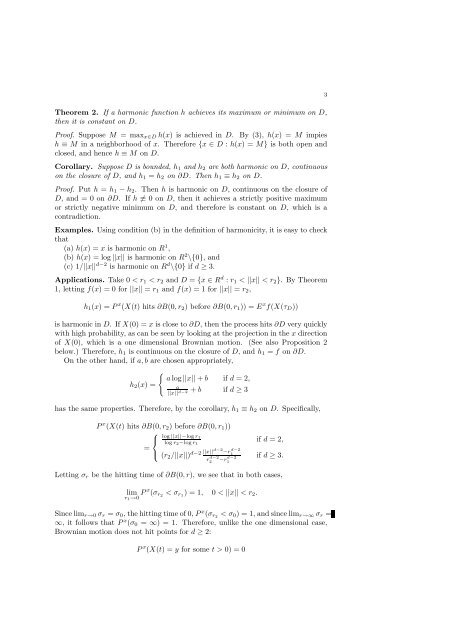Brownian Motion and the Dirichlet Problem - UCLA Department of ...
Brownian Motion and the Dirichlet Problem - UCLA Department of ...
Brownian Motion and the Dirichlet Problem - UCLA Department of ...
You also want an ePaper? Increase the reach of your titles
YUMPU automatically turns print PDFs into web optimized ePapers that Google loves.
Theorem 2. If a harmonic function h achieves its maximum or minimum on D,<br />
<strong>the</strong>n it is constant on D.<br />
Pro<strong>of</strong>. Suppose M = maxx∈D h(x) is achieved in D. By (3), h(x) = M impies<br />
h ≡ M in a neighborhood <strong>of</strong> x. Therefore {x ∈ D : h(x) = M} is both open <strong>and</strong><br />
closed, <strong>and</strong> hence h ≡ M on D.<br />
Corollary. Suppose D is bounded, h1 <strong>and</strong> h2 are both harmonic on D, continuous<br />
on <strong>the</strong> closure <strong>of</strong> D, <strong>and</strong> h1 = h2 on ∂D. Then h1 ≡ h2 on D.<br />
Pro<strong>of</strong>. Put h = h1 − h2. Then h is harmonic on D, continuous on <strong>the</strong> closure <strong>of</strong><br />
D, <strong>and</strong> = 0 on ∂D. If h ≡ 0 on D, <strong>the</strong>n it achieves a strictly positive maximum<br />
or strictly negative minimum on D, <strong>and</strong> <strong>the</strong>refore is constant on D, which is a<br />
contradiction.<br />
Examples. Using condition (b) in <strong>the</strong> definition <strong>of</strong> harmonicity, it is easy to check<br />
that<br />
(a) h(x) = x is harmonic on R 1 ,<br />
(b) h(x) = log ||x|| is harmonic on R 2 \{0}, <strong>and</strong><br />
(c) 1/||x|| d−2 is harmonic on R d \{0} if d ≥ 3.<br />
Applications. Take 0 < r1 < r2 <strong>and</strong> D = {x ∈ R d : r1 < ||x|| < r2}. By Theorem<br />
1, letting f(x) = 0 for ||x|| = r1 <strong>and</strong> f(x) = 1 for ||x|| = r2,<br />
h1(x) = P x (X(t) hits ∂B(0, r2) before ∂B(0, r1)) = E x f(X(τD))<br />
is harmonic in D. If X(0) = x is close to ∂D, <strong>the</strong>n <strong>the</strong> process hits ∂D very quickly<br />
with high probability, as can be seen by looking at <strong>the</strong> projection in <strong>the</strong> x direction<br />
<strong>of</strong> X(0), which is a one dimensional <strong>Brownian</strong> motion. (See also Proposition 2<br />
below.) Therefore, h1 is continuous on <strong>the</strong> closure <strong>of</strong> D, <strong>and</strong> h1 = f on ∂D.<br />
On <strong>the</strong> o<strong>the</strong>r h<strong>and</strong>, if a, b are chosen appropriately,<br />
h2(x) =<br />
a log ||x|| + b if d = 2,<br />
a<br />
||x|| d−2 + b if d ≥ 3<br />
has <strong>the</strong> same properties. Therefore, by <strong>the</strong> corollary, h1 ≡ h2 on D. Specifically,<br />
P x (X(t) hits ∂B(0, r2) before ∂B(0, r1))<br />
⎧<br />
⎨<br />
=<br />
⎩<br />
log ||x||−log r1<br />
log r2−log r1<br />
(r2/||x||) d−2 ||x||d−2−r d−2<br />
1<br />
r d−2<br />
2 −rd−2<br />
1<br />
if d = 2,<br />
if d ≥ 3.<br />
Letting σr be <strong>the</strong> hitting time <strong>of</strong> ∂B(0, r), we see that in both cases,<br />
lim<br />
r1→0 P x (σr2 < σr1) = 1, 0 < ||x|| < r2.<br />
Since limr→0 σr = σ0, <strong>the</strong> hitting time <strong>of</strong> 0, P x (σr2 < σ0) = 1, <strong>and</strong> since limr→∞ σr =<br />
∞, it follows that P x (σ0 = ∞) = 1. Therefore, unlike <strong>the</strong> one dimensional case,<br />
<strong>Brownian</strong> motion does not hit points for d ≥ 2:<br />
P x (X(t) = y for some t > 0) = 0<br />
3
















